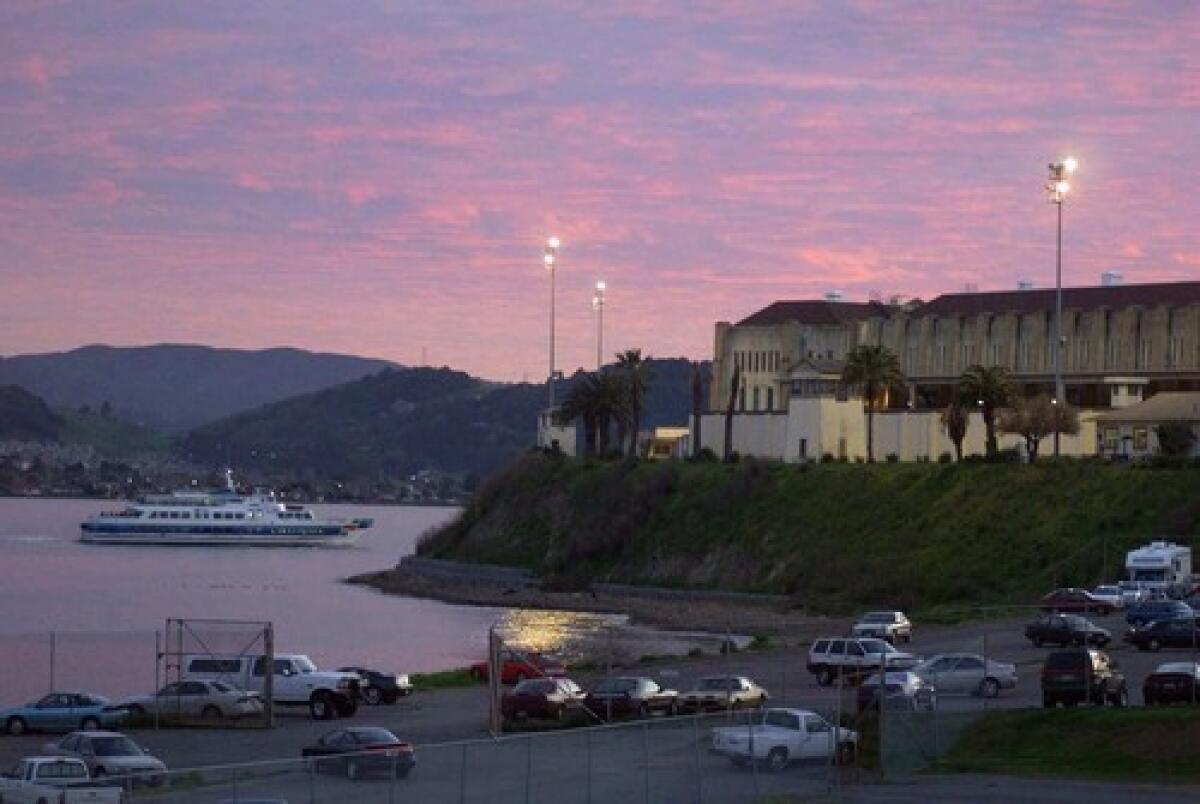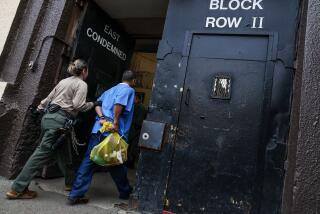Editorial: Every prison cell is now a coronavirus death row

- Share via
San Quentin is California’s most famous, most picturesque, most aged, most poorly designed and most lethal state prison. Its parking lot, down the hill from twin gothic towers (built in the 1850s) and high walls, offers a stunning view of San Francisco Bay and the Bay Bridge — when not threatened by winter storm waves. The perspective is different inside the gates, where cellblocks surround an open atrium-like space designed to give guards a view of each inmate. With the windows to the outside closed off and with prisoners and guards all breathing the same poorly circulated air, it’s the perfect place to transmit a virus, quickly and mercilessly. In such an environment, social distancing is irrelevant.
In other words, it’s not a good place to send inmates to shield them from COVID-19.
About 400 miles to the south, at the California Institute for Men in Chino (built in the 1940s), the coronavirus spread swiftly among more than 600 inmates, causing multiple deaths and putting other inmates directly in harm’s way. So hundreds of medically vulnerable inmates were moved to other prisons, including San Quentin. Some few brought the virus with them, and San Quentin now has more than 1,400 cases, each of them potentially fatal. The prison’s notorious execution chamber has been quiet for 14 years, but now every San Quentin inmate is effectively on death row.
This was going to happen, one way or another. Prisons, like cruise ships and nursing homes, are virus breeding grounds and human death traps. Two thirds of inmates at the federal prison at Terminal Island, across the shipping channel from San Pedro, were infected by May. Nearly 70% of inmates at the federal prison in Lompoc tested positive. COVID-19 infections ripped through prisons in New York, Chicago, Ohio. California’s 35 state prisons suffered just a few infections, but were living and breathing on borrowed time.
The only way to decrease the risk is to decrease the inmate population, and the state made only the most modest effort at that earlier this year, halting new admissions for a few weeks and moving up the departure dates slightly for about 3,500 home-bound prisoners.
Now Gov. Gavin Newsom’s administration is finally getting more serious about reducing the infection risk by reducing the inmate population. Departure dates will be moved up for thousands of additional prisoners, including some elderly and medically frail inmates who have been locked up for years and who now pose little risk to their home communities. Ironically, and tragically, California still has people locked up who, on release, would be good candidates for nursing homes, were they also not hot spots for COVID-19.
Every prison is not just a disease vector for other inmates but, through employees and visitors, a serious threat to neighboring communities. Even the state’s newer, relatively isolated prisons, such as Ironwood and Chuckawalla outside Blythe, pose high danger to populated areas because it turns out that many employees choose not to live in Blythe but would rather drive the two hours each way from either Palm Springs or Phoenix. It’s the same with other prisons up and down the state.
San Quentin has the best inmate education, training and rehabilitation programs because its unlikely location allows it to draw experts from nearby UC Berkeley and mission-driven teachers from Oakland and Silicon Valley. But that means that those areas, too, are more vulnerable to infections spreading across the prison.
Why do we do this? Why do we consider it a good idea to use long years of confinement in unhealthy, densely-packed prisons as our best response to people who have hurt others or otherwise violated community standards? In some countries, prisons more closely resemble schools or health facilities, because that’s essentially what they are. None of this is to say we should scrap punishment and confinement for murderers or rapists. But not every convicted criminal deserves to be put on the coronavirus death row.
Newsom’s release plan is a good start, but it’s only that. Inmates who must stay locked up should get more space between them, and frequent testing with rapid reporting of results. The medical and elderly parole programs should be stepped up, and quickly. Dorm-style inmate quarters should be shut down, as should San Quentin’s most disease-prone quarters, and perhaps the entire prison. If a bar or a restaurant is too enclosed to be a safe space, then so are many parts of prisons.
And even then, the state’s inmate population will likely fall to the level that its prisons were originally designed to hold, meaning they will still be full. Does that make us safer? Not during this singular moment in history. And just maybe, not ever.
More to Read
A cure for the common opinion
Get thought-provoking perspectives with our weekly newsletter.
You may occasionally receive promotional content from the Los Angeles Times.










